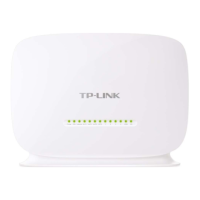GET STARTED
TM
Connecting Your TP-Link TD-VG5612 to ADSL / VDSL (NBN FTTB/N)
To connect your modem router to ADSL / VDSL, follow the steps below. FTTB/N will be using VDSL
technologies.
TM
TP-Link TD-VG5612
1. For Naked ADSL / VDSL, connect your phone line directly into the ADSL / VDSL port of the
modem router.
2. For traditional ADSL / VDSL, use the splitter for your PSTN analogue telephone, as shown in
the diagram above:
a) Connect your phone line to the Line port of the splitter.
b) Connect the white telephone cable from the ADSL / VDSL port of the splitter to the DSL
port of the modem router.
c) Connect your analogue telephone to the Phone port of the splitter to make PSTN calls.
3. To save on calls by using VoIP, connect your analogue telephone(s) to the “Phone” pot(s) of
the modem router, as shown in the diagram above.
4. You can connect your computer to one of the yellow LAN ports of the modem router using
the network cable. Do not connect to the LAN/WAN port. For wireless connections, please
refer to the Wireless Access section.
The modem router is designed to automatically connect to your MyNetFone service, if you require
further assistance, please contact MyNetFone on 1300 731 048 (residential), 1300 887 899
(business) and select option 2 or dial 181 from your MyNetFone service.
Power
Supply
Power
On/Off
3 Ethernet
LAN Ports
LAN/WAN for
NBN FTTP/
Wireless/HFC
3
For VoIP Service
For Traditional Phone Service
ModemPhone
Phone Jack
2
Splitter
Making Phone Calls
Both VoIP calls and PSTN calls can be made and received using this modem router.
Even if you are currently using PSTN, you can start making VoIP calls by simply connecting your
existing analogue telephone to one of the Phone ports of the modem router.
Included Basic Voice Plan
If you haven’t chosen any of the MyNetFone high valued VOIP plan associated with DSL or NBN
services, a Pay-as-you-go “Basic Voice” plan is made available for you.
The ‘Basic Voice’ plan has no monthly fee, so you would only pay for the calls you make. This is
a great way of trying out VOIP services and start saving on your phone call costs. However it is
completely up to you whether you would like to use this service or not.
By Default any calls made via handsets connected to the “Phone” port of the modem router will
be sent and received via the MyNetFone VOIP service. For using traditional PSTN incoming and
outgoing calls, you need to connect a handset to the phone port of the splitter, as the modem
does not have a “Line” port.
Voice Plan Rates and Options
Please visit the following link to know the call rates of our “Basic Voice Plan”.
Residential:
https://www.mynetfone.com.au/Residential/Home-Internet/NakedDSL-Plans/basic-voice
Business:
https://business.mynetfone.com.au/legal/standard-rates-fees
To upgrade to a high valued plan, please give our friendly sales team a call on 1300 731 048
(residential) 1300 887 899 (business) and select option 1 or visit the following links:
Residential:
https://www.mynetfone.com.au/Residential/Home-Phone/Plans
Business:
https://business.mynetfone.com.au/phone-systems
Caution: Please Power-On the modem only after DSL cable is plugged in.

